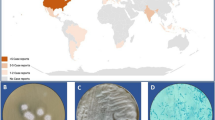Abstract
Dermatophytosis is caused by keratinophilic dermatophytes and affects the superficial skin and its appendages. The nature of infection and response to treatment is influenced by host–pathogen factors like duration and severity of disease, prior drug history and type of causative organism. In our study, the burden of dermatophytosis affecting glabrous skin saw a rise in recalcitrant and reinfection cases with only 1.6% achieving complete cure. Chronicity of dermatophytic infection was reflected in the high serum IgE levels and immediate hypersensitivity reactions. Hence, it becomes pertinent for clinicians to identify the non-responders and modify therapy to achieve clinical cure with fungal clearance confirmed by mycological tools.
Similar content being viewed by others
References
Marques S, Robles A, Tortorano A, Tuculet M, Negroni R, Mendes R. Mycoses associated with AIDS in the third world. Med Mycol. 2000;38(1):269–79.
Lakshmanan A, Ganesh Kumar P, Mohan SR, HemaMalini M, Madhavan R. Epidemiological and clinical pattern of dermatomycoses in rural India. Indian J Med Microbiol. 2015;33(5):134–6.
Zhan P, Liu W. The changing face of dermatophytic infections worldwide. Mycopathologia. 2017;182(1–2):77–86.
Chinnapun D, Thammarat NS. Virulence factors involved in pathogenicity of dermatophytes. Walailak J Sci Technol. 2015;12(7):573–80.
Monod M, Lechenne B, Jousson O, Grand D, Zaugg C, Stocklin R, et al. Aminopetidases and dipeptidyl-peptidases secreted by the dermatophyte Trichophyton rubrum. Microbiology. 2005;151(1):145–55.
Rudramurthy S, Shankarnarayan S, Dogra S, Shaw D, Mushtaq K, Paul R, et al. Mutation in the squalene epoxidase gene of Trichophyton interdigitale and Trichophyton rubrum associated with allylamine resistance. Antimicrob Agents Chemother. 2018. https://doi.org/10.1128/AAC.02522-17.
Dabas Y, Xess I, Singh G, Pandey M, Meena S. Molecular identification and antifungal susceptibility patterns of clinical dermatophytes following CLSI and EUCAST guidelines. J Fungi. 2017;3(2):17.
Dogra S, Uprety S. The menace of chronic and recurrent dermatophytosis in India: Is the problem deeper than we perceive? Indian Dermatol Online J. 2016;7(2):73–6.
Gupta C, Das S, Ramachandran VG, Saha R, Bhattacharya SN, Dar SA, et al. Possible role of trichophytin antigen in inducing impaired immunological clearance of fungus in onychomycosis. Mycopathologia. 2016;181(3–4):247–51.
White TJ, Bruns T, Lee S, Taylor JW. Amplification and direct sequencing of fungal ribosomal RNA genes for phylogenetics. In: Innis MA, Gelfand DH, Sninsky JJ, White TJ, editors. PCR protocols: a guide to methods and applications. San Diego: Academic Press Inc; 1990. p. 315–22.
Verma S, Madhu R. The great Indian epidemic of superficial dermatophytosis: an appraisal. Indian J Dermatol. 2017;62(3):227–36.
Peerapur BBV, Inamdar AC, Pushpa PV, Microbiol M, Srikant B, Microbiol M. Clinicomycological study of dermatophytosis in Bijapur. Indian J Med Microbiol. 2004;22(4):273–5.
Surendran K, Bhat RR, Boloor R, Nandakishore B, Sukumar D. A clinical and mycological study of dermatophytic infections. Indian J Dermatol. 2014;59(3):262–7.
Sahai S, Mishra D. Change in spectrum of dermatophytes isolated from superficial mycoses cases: first report from Central India. Indian J Dermatol Venereol Leprol. 2011;77(3):335–6.
Shukla P, Yaqoob S, Haider F, Shukla V. Dermatophytoses; epidemiology and distribution among urban and sub urban population. Indian J Microbiol Res. 2016;3(3):292–8.
Singh A, Masih A, Khurana A, Singh P, Gupta M, Hagen F, et al. High terbinafine resistance in Trichophyton interdigitale isolates in Delhi, India harbouring mutations in the squalene epoxidase gene. Mycoses. 2018. https://doi.org/10.1111/myc.12772.
Woodfolk JA. Allergy and dermatophytes. Clin Microbiol Rev. 2005;18(1):30–43.
Gupta AK, Chaudhry M, Elewski B. Tinea corporis, tinea cruris, tinea nigra, and piedra. Dermatol Clin. 2003;21(3):395–400.
de Hoog GS, Dukik K, Monod M, Packeu A, Stubbe D, Hendrickx M, et al. Toward a novel multilocus phylogenetic taxonomy for the dermatophytes. Mycopathologia. 2017;182(1–2):5–31.
Nenoff P, Verma SB, Uhrlaß S, Burmester A, Gräser Y. A clarion call for preventing taxonomical errors of dermatophytes using the example of the novel Trichophyton mentagrophytes genotype VIII uniformly isolated in the Indian epidemic of superficial dermatophytosis. Mycoses. 2018. https://doi.org/10.1111/myc.12848.
Acknowledgements
This work was supported by the Intramural Grant from the University College of Medical Sciences & Guru Teg Bahadur Hospital, Delhi, India.
Author information
Authors and Affiliations
Corresponding author
Ethics declarations
Conflict of interest
The authors state no conflict of interest.
Ethical Approval
All procedures performed in studies involving human participants were in accordance with the ethical standards of the institutional research committee and with the 1964 Declaration of Helsinki and its later amendments or comparable ethical standards.
Additional information
Handling editor: Stephane Ranque.
Electronic Supplementary Material
Below is the link to the electronic supplementary material.
Rights and permissions
About this article
Cite this article
Tigga, R.A., Das, S., Bhattacharya, S.N. et al. Burden of Chronic Dermatophytosis in a Tertiary Care Hospital: Interaction of Fungal Virulence and Host Immunity. Mycopathologia 183, 951–959 (2018). https://doi.org/10.1007/s11046-018-0303-4
Received:
Accepted:
Published:
Issue Date:
DOI: https://doi.org/10.1007/s11046-018-0303-4




